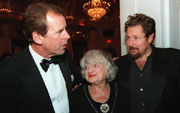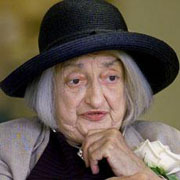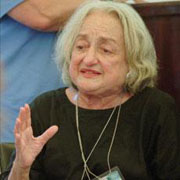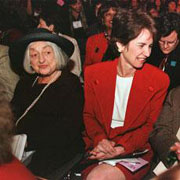-
(单词翻译:双击或拖选)
PEOPLE IN AMERICA - Betty Friedan, 1921-2006: A Leader of the Modern Women’s Rights Movement
FAITH LAPIDUS: I’m Faith Lapidus.
STEVE EMBER: And I’m Steve Ember with PEOPLE IN AMERICA in VOA Special English. Today we tell about Betty Friedan. She was a powerful activist1 for the rights of women.
(MUSIC)
FAITH LAPIDUS: Betty Friedan is often called “the mother of the modern women’s liberation movement.” Her famous book, “The Feminine Mystique,” changed America. Some people say it changed the world. It has been called one of the most influential2 nonfiction books of the twentieth century.
Friedan re-awakened the feminist3 movement in the United States. That movement had helped women gain the right to vote in the nineteen twenties. Modern feminists4 disagree about how to describe themselves and their movement. But activists5 say men and women should have equal chances for economic, social and intellectual satisfaction in life.
 |
| Peter Jennings, left, Betty Friedan, center, and Julian Schnabel stop for a chat after receiving Lifetime Achievment Awards from the Academy of the Arts in New York |
STEVE EMBER: Fifty years ago, life for women in the United States was very different from today. Very few parents urged their daughters to become lawyers or doctors or professors. Female workers doing the same jobs as men earned much less money. Women often lost their jobs when they had a baby. There were few child-care centers for working parents.
Betty Friedan once spoke6 to ABC television about her support for sharing responsibility for the care of children.
BETTY FRIEDAN: “If child-rearing was considered the responsibility of women and men or women and men and society, then we really could pull up our skirts and declare victory and move on.”
(MUSIC)
FAITH LAPIDUS: Betty Friedan was born Betty Goldstein in nineteen twenty-one in Peoria, Illinois. Her immigrant father worked as a jeweler. Her mother left her job with a local newspaper to stay home with her family.
 |
| Betty Friedan laid the groundwork for the modern feminist movement |
Betty attended Smith College in Northhampton, Massachusetts. It was one of the country’s best colleges for women. She finished her studies in psychology7 in nineteen forty-two.
After college she attended the University of California at Berkeley to continue her studies. Her boyfriend at the time did not want her to get an advanced degree in psychology. He apparently8 felt threatened by her success. So Betty left California and her boyfriend. She moved to New York City and worked as a reporter and editor for labor9 union newspapers.
In nineteen forty-seven, Betty Goldstein married Carl Friedan, a theater director who later became an advertising10 executive. They had a child, the first of three. The Friedans were to remain married until nineteen sixty-nine.
(MUSIC)
STEVE EMBER: When Betty Friedan became pregnant for the second time, she was dismissed from her job at the newspaper. After that she worked as an independent reporter for magazines. But her editors often rejected her attempts to write about subjects outside the traditional interests of women.
In nineteen fifty-seven, Friedan started research that was to have far-reaching results. Her class at Smith College was to gather for the fifteenth anniversary of their graduation. Friedan prepared an opinion study for the women. She sent questions to the women about their lives. Most who took part in the study did not work outside their homes.
Friedan was not completely satisfied with her life. She thought that her former college classmates might also be dissatisfied. She was right. Friedan thought these intelligent women could give a lot to society if they had another identity besides being homemakers.
FAITH LAPIDUS: Friedan completed more studies. She talked to other women across the country. She met with experts about the questions and answers. She combined this research with observations and examples from her own life. The result was her book, “The Feminine Mystique,” published in nineteen sixty-three.
The book attacked the popular idea of the time that women could only find satisfaction through being married, having children and taking care of their home. Friedan believed that women wanted more from life than just to please their husbands and children.
 |
| She said in 1995 that the women's movement must move away from "sexual politics" to work with men in humanity's common interest |
The book said women suffered from feelings of lack of worth. Friedan said this was because the women depended on their husbands for economic, emotional and intellectual support.
STEVE EMBER: “The Feminine Mystique” was a huge success. It has sold more than three million of copies. It was reprinted in a number of other languages. The book helped change the lives of women in America. More women began working outside the home. More women also began studying traditionally male subjects like law, medicine and engineering.
Betty Friedan expressed the dissatisfaction of some American women during the middle of the twentieth century. But she also made many men feel threatened. Later, critics said her book only dealt with the problems of white, educated, wealthy, married women. It did not study the problems of poor white women, single women or minorities.
(MUSIC)
FAITH LAPIDUS: In nineteen sixty-six, Betty Friedan helped establish NOW, the National Organization for Women. She served as its first president. She led campaigns to end unfair treatment of women seeking jobs.
BETTY FRIEDAN: “We are now strong enough ourselves to see men not as bread winners, not as instruments, not as sex objects, not as enemies, not as stereotypes11, but human beings, our brothers.”
FAITH LAPIDUS: Friedan also worked on other issues. She wanted women to have the choice to end their pregnancies12. She wanted to create child-care centers for working parents. She wanted women to take part in social and political change. Betty Friedan once spoke about her great hopes for women in the nineteen seventies.
BETTY FRIEDAN: “Liberating ourselves, we will then become a major political force, perhaps the biggest political force for basic social and political change in America in the seventies.”
STEVE EMBER: Betty Friedan led a huge demonstration13 in New York City for women’s rights. Demonstrations14 were also held in other cities. A half-million women took part in the Women’s Strike for Equality on August twenty-sixth, nineteen seventy. The day marked the fiftieth anniversary of American women gaining the right to vote.
A year after the march, Friedan helped establish the National Women’s Political Caucus15. She said the group got started “to make policy, not coffee.” She said America needed more women in public office if women were to gain equal treatment.
FAITH LAPIDUS: Friedan wanted a national guarantee of that equal treatment. She worked tirelessly to get Congress and the states to approve an amendment16 to the United States Constitution that would provide equal rights for women.
 |
| Betty Friedan and Lt. Gov. Kathleen Kennedy Townsend at the Feminist Expo 2000 in Baltimore, Maryland |
The House of Representatives approved this Equal Rights Amendment in nineteen seventy-one. The Senate approved it the following year. Thirty-eight of the fifty state legislatures were required to approve the amendment. Congress set a time limit of seven years for the states to approve it. This was extended to June thirtieth, nineteen eighty-two. However, only thirty-five states approved the amendment by the deadline so it never went into effect.
The defeat of the E.R.A. was a sad event for Betty Friedan, NOW, and other activists.
(MUSIC)
STEVE EMBER: In nineteen eighty-one, Betty Friedan wrote about the condition of the women’s movement. Her book was called “The Second Stage.” Friedan wrote that the time for huge demonstrations and other such events had passed. She urged the movement to try to increase its influence on American political life.
Some younger members of the movement denounced her as too conservative.
As she grew older, Friedan studied conditions for older Americans. She wrote a book called “The Fountain of Age” in nineteen ninety-three. She wrote that society often dismisses old people as no longer important or useful. Friedan’s last book was published in two thousand. She was almost eighty years old at the time. Its title was “Life So Far.”
Betty Friedan died on February fourth, two thousand six. It was her eighty-fifth birthday. Betty Friedan once told a television reporter how she wanted to be remembered.
BETTY FRIEDAN: “She helps make it better for women to feel good about being women, and therefore she helped make it possible for women to more freely love men.”
(MUSIC)
FAITH LAPIDUS: This program was written by Jerilyn Watson. It was produced by Lawan Davis. I’m Faith Lapidus.
STEVE EMBER: And I’m Steve Ember. You can download a transcript17 and audio of this show at voanews.cn. Join us again next week for PEOPLE IN AMERICA in VOA Special English.
 收听单词发音
收听单词发音
1
activist

|
|
| n.活动分子,积极分子 | |
参考例句: |
|
|
|
2
influential

|
|
| adj.有影响的,有权势的 | |
参考例句: |
|
|
|
3
feminist

|
|
| adj.主张男女平等的,女权主义的 | |
参考例句: |
|
|
|
4
feminists

|
|
| n.男女平等主义者,女权扩张论者( feminist的名词复数 ) | |
参考例句: |
|
|
|
5
activists

|
|
| n.(政治活动的)积极分子,活动家( activist的名词复数 ) | |
参考例句: |
|
|
|
6
spoke

|
|
| n.(车轮的)辐条;轮辐;破坏某人的计划;阻挠某人的行动 v.讲,谈(speak的过去式);说;演说;从某种观点来说 | |
参考例句: |
|
|
|
7
psychology

|
|
| n.心理,心理学,心理状态 | |
参考例句: |
|
|
|
8
apparently

|
|
| adv.显然地;表面上,似乎 | |
参考例句: |
|
|
|
9
labor

|
|
| n.劳动,努力,工作,劳工;分娩;vi.劳动,努力,苦干;vt.详细分析;麻烦 | |
参考例句: |
|
|
|
10
advertising

|
|
| n.广告业;广告活动 a.广告的;广告业务的 | |
参考例句: |
|
|
|
11
stereotypes

|
|
| n.老套,模式化的见解,有老一套固定想法的人( stereotype的名词复数 )v.把…模式化,使成陈规( stereotype的第三人称单数 ) | |
参考例句: |
|
|
|
12
pregnancies

|
|
| 怀孕,妊娠( pregnancy的名词复数 ) | |
参考例句: |
|
|
|
13
demonstration

|
|
| n.表明,示范,论证,示威 | |
参考例句: |
|
|
|
14
demonstrations

|
|
| 证明( demonstration的名词复数 ); 表明; 表达; 游行示威 | |
参考例句: |
|
|
|
15
caucus

|
|
| n.秘密会议;干部会议;v.(参加)干部开会议 | |
参考例句: |
|
|
|
16
amendment

|
|
| n.改正,修正,改善,修正案 | |
参考例句: |
|
|
|
17
transcript

|
|
| n.抄本,誊本,副本,肄业证书 | |
参考例句: |
|
|
|















